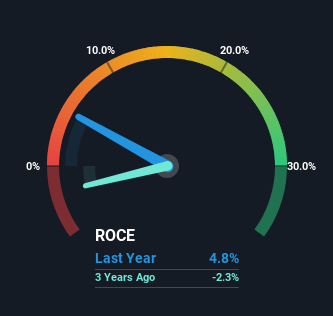Banyan Tree Holdings (SGX:B58) Shareholders Will Want The ROCE Trajectory To Continue
If you're looking for a multi-bagger, there's a few things to keep an eye out for. One common approach is to try and find a company with returns on capital employed (ROCE) that are increasing, in conjunction with a growing amount of capital employed. Basically this means that a company has profitable initiatives that it can continue to reinvest in, which is a trait of a compounding machine. Speaking of which, we noticed some great changes in Banyan Tree Holdings' (SGX:B58) returns on capital, so let's have a look.
What Is Return On Capital Employed (ROCE)?
For those who don't know, ROCE is a measure of a company's yearly pre-tax profit (its return), relative to the capital employed in the business. To calculate this metric for Banyan Tree Holdings, this is the formula:
Return on Capital Employed = Earnings Before Interest and Tax (EBIT) ÷ (Total Assets - Current Liabilities)
0.048 = S$66m ÷ (S$1.7b - S$375m) (Based on the trailing twelve months to December 2023).
Thus, Banyan Tree Holdings has an ROCE of 4.8%. In absolute terms, that's a low return, but it's much better than the Hospitality industry average of 3.9%.
Check out our latest analysis for Banyan Tree Holdings
Above you can see how the current ROCE for Banyan Tree Holdings compares to its prior returns on capital, but there's only so much you can tell from the past. If you'd like to see what analysts are forecasting going forward, you should check out our free analyst report for Banyan Tree Holdings .
What Can We Tell From Banyan Tree Holdings' ROCE Trend?
While the ROCE isn't as high as some other companies out there, it's great to see it's on the up. Looking at the data, we can see that even though capital employed in the business has remained relatively flat, the ROCE generated has risen by 248% over the last five years. Basically the business is generating higher returns from the same amount of capital and that is proof that there are improvements in the company's efficiencies. The company is doing well in that sense, and it's worth investigating what the management team has planned for long term growth prospects.
What We Can Learn From Banyan Tree Holdings' ROCE
As discussed above, Banyan Tree Holdings appears to be getting more proficient at generating returns since capital employed has remained flat but earnings (before interest and tax) are up. Given the stock has declined 45% in the last five years, this could be a good investment if the valuation and other metrics are also appealing. So researching this company further and determining whether or not these trends will continue seems justified.
On a final note, we've found 1 warning sign for Banyan Tree Holdings that we think you should be aware of.
While Banyan Tree Holdings isn't earning the highest return, check out this free list of companies that are earning high returns on equity with solid balance sheets.
Have feedback on this article? Concerned about the content? Get in touch with us directly. Alternatively, email editorial-team (at) simplywallst.com.
This article by Simply Wall St is general in nature. We provide commentary based on historical data and analyst forecasts only using an unbiased methodology and our articles are not intended to be financial advice. It does not constitute a recommendation to buy or sell any stock, and does not take account of your objectives, or your financial situation. We aim to bring you long-term focused analysis driven by fundamental data. Note that our analysis may not factor in the latest price-sensitive company announcements or qualitative material. Simply Wall St has no position in any stocks mentioned.

 Yahoo Finance
Yahoo Finance 
